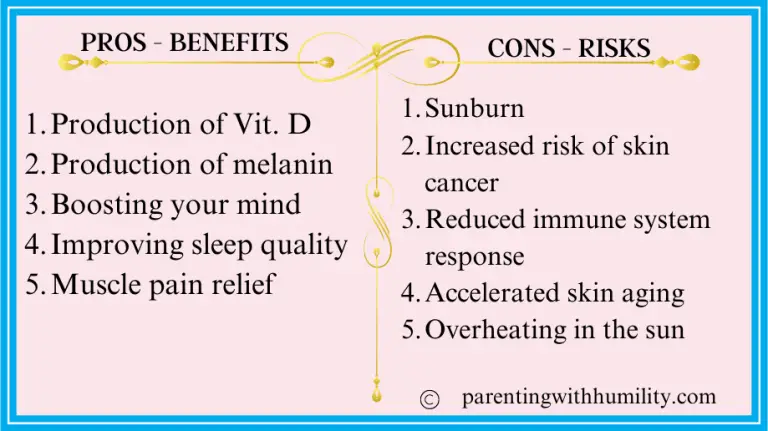Introduction:
While being pregnant comes with a lot of extra caution regarding how you manage your health and that of your developing baby, there are other regular fun things you may want to engage in but are unsure about the health implication.
Tanning while pregnant is one of those things many of us women look towards to, but we seek to know the pros and cons before going tanning. Of course, you want to experience that skin glow on your bump and flaunt it, but before that, read this.
This article aims to comprehensively cover every aspect of tanning while pregnant, its pros and cons, and you can trust that all your questions are answered and all your doubts cleared.
Read also: Swimming in Beach or Ocean While Pregnant: Are ocean waves hitting the pregnant belly safe?
What is Tanning?

Tanning, or sun tanning as it is popularly called, is the process of darkening the skin coloring by deliberate exposure to sunlight (sunbathing) or artificial sources like tanning beds and other chemical products (sunless tanning) like spray tans.
The ultraviolet rays (UV rays) are responsible for the new coloration that happens. The UV rays (UVA) reach the top layer of your skin (epidermis) and trigger the production of melanin, a brown coloration pigment found under the skin.
Many people do this passionately for recreational purposes, while many others look towards it for its skin health benefits like;
- production of Vit. D
- production of melanin, which further protects the skin from damage caused by the same UV rays
Notwithstanding, tanning generally has its CONS also.
Notwithstanding, tanning generally has its potential risks also.
Excessive exposure, on the other hand, can lead to;
- sunburn (more likely among people with light skin)
- increased risk of skin cancer (melanoma, basal and squamous cell carcinoma)
- reduced immune system response
- accelerated skin aging (premature aging)
- wrinkles, sagging skin, dark spots
You may already have several questions yearning for answers, like, can you tan while pregnant, or can you get a spray tan while pregnant?
Not to worry, this article covers all and more. In no order of hierarchy, let’s start with the pros and cons of tanning while pregnant.
Pros and Cons of Tanning While Pregnant

As with everything that has its benefits or advantages, there may also be a disadvantage.
The Pros and Cons of tanning during pregnancy include the following and extend even beyond when pregnant;
Pros – Benefits
- Production of Vit. D
- Production of melanin (protection from sunburn)
- Boosting your mind
- Improving sleep quality
- Muscle pain relief
(1.) Production of Vit. D – you need healthy bones and muscles when pregnant to support the weight of your bump. Vitamin D regulates the production of calcium and phosphorus.
These elements also help your baby in the formation of their bones, teeth, kidneys, and nervous system.
To enjoy the benefit of this Vit. D, exposure to sunlight will be better than sunless tanning. Tanning beds do not offer this benefit at all.
(2.) Production of Melanin (protection from sunburn) – as much as you want that colorful glow on your body and bump when pregnant, the melanin produced further helps you down the line. Melanin production protects you from sunburn.
If your way of enjoying the summer comes by visiting the beach when pregnant and don’t mind the ocean waves hitting your pregnant belly, tanning may be it for you to protect you from sunburn.
(3.) Boosting your mood – exposure to sunlight does not only have the benefits of producing Vit. D or melanin, but also stimulates the production of serotonin,(1) the happy hormone.
With hormonal fluctuations common in pregnancy and the cramps that come with it, such as cravings and mood swings, serotonin is just about the game changer to help with such moody moments, making you happier and keeping you calm.
(4.) Improving Sleep Quality – this goes in line with boosting your mind. While serotonin production stimulated by sunlight improves your mood and calms you, the same sunlight causes your brain to produce an optimal level of melatonin(2) at night, which further helps and improves your sleep cycle.
The benefit of this as a pregnant woman is that it improves your developing fetus. Insufficient sleep when pregnant may reduce the growth hormone released for your growing baby, which can lead to growth problems.
On the other hand, lack of enough sleep(3) during pregnancy could lead to pregnancy complications such as high blood pressure,
(5.) Muscle Pain Relief – tanning magically helps relax the muscles, relieving you of that stretched pain you may be feeling from your bump and your body generally.
You can get this effect from sunbeds in case you don’t want to go sunbathing. Remember, sunbeds have more risk of causing skin cancer.
Cons – Risk of Tanning During Pregnancy
While the possible CONS of tanning during pregnancy may not have any immediate risk to your growing baby, like the Pros that it benefits the baby directly, the dangers of tanning will be on you in the longer term.
The following are CONS of tanning;
- sunburn (more likely among people with light skin)
- increased risk of skin cancer (melanoma, basal and squamous cell carcinoma)
- reduced immune system response
- accelerated skin aging (premature aging – wrinkles, sagging skin, dark spots)
- overheating in the sun
(1.) Sunburn – in as much as the sunlight falling on your body stimulates the production of melanin to protect your skin from further UV Rays, excessive exposure can cause you more damage – sunburn.
(2.) Increased risk of cancer – the sun’s ultraviolet rays are of two types (4) – the UVA and UVB, which are longer and shorter wavelengths, respectively. UVA is associated with tanning and skin aging, while UVB with skin burning.
UVA, on the one hand, causes melanoma skin cancer which can spread throughout the body and be very dangerous
On the other hand, UVB is responsible for two types of cancer – basal cell carcinoma (BCC) and squamous cell carcinoma (SCC). These types of cancer affect the sun-exposed area of the skin. Fortunately, when detected early, they can be cured. Treatment is by a surgical procedure to cut off the affected areas.
This risk of cancer is common with sunlight and tanning beds, which is worse.
Nonetheless, a proactive means to protect yourself (reduce your risk) when you’re under the sun is to use sunscreen with a sun protection factor (SPF) of at least 30.
(3.) Reduced immune system response – there are studies reported (5,6), that have shown that overexposure to sunlight suppresses the immune system response to certain invasions.
(4.) Accelerated skin aging – The UVA of UV rays is responsible for premature skin aging, such as wrinkles, sagging skin, and dark spots.
As a pregnant woman anticipating delivery soonest, you don’t want the effect of a postpartum belly to remain long after birth because of developing sagging skin from tanning.
Therefore, Can You Tan While Pregnant?
Tanning during pregnancy is relatively safe, depending on the method you go with. While tanning with the sunlight generally offers health benefits like the production of Vit. D, other tanning methods like tanning beds do not provide such, instead is more dangerous as there is a higher risk of skin cancer (melanoma).
Sunless tanners are safer and are recommended when pregnant and when not, also.
However, tanning will not harm your growing baby.
Tanning During Pregnancy – First, Second, and Third Trimesters
While tanning during pregnancy has no risk on your baby at any stage of pregnancy, the general rule of thumb is to avoid overexposure to UV rays, be it from sunlight or tanning beds.
Tanning and Spray Tanning – Any Difference?
Tanning, or sun tanning, as it is popularly called, is the deliberate darkening of the skin color by exposure to sunlight. In contrast, spray tanning is a sunless tanning method that makes your skin have a tanned look like you were exposed to sunlight.
Methods of Tanning – Sun, Sunless, Spray Tan, & Tanning Bed – When Pregnant

Sun Tanning
This is the conventional old-fashion way of tanning that involves lying under the sun. As a pregnant woman, you lay on your back with your pregnant belly up against the sun.
Note, there is the risk of UV rays from sunlight, albeit its health benefits of Vit. D., and the production of serotonin,(1) the happy hormone.
Sunless Tanning
This is using creams or lotions on your skin to imitate the effect of tanning. It makes your skin have that sun-kissed look. Examples are spray tanning and self-tanning.
This way, you are not exposed to the risk of any UV rays from lying under direct sunlight or on a tanning bed.
You still get to enjoy that swag of a melanin-popping baby bump.
Spray Tan
Spray tanning is a safe sunless tanning method that makes the skin have a tanned look like you were exposed to sunlight.
The effect is caused when the active ingredient, DHA, reacts with amino acids in your skin to give that darkening effect.
Some spray tanning products, also called stainers, contain dihydroxyacetone (DHA), a chemical substance that causes a chemical reaction on the skin leading to the darkening effect. However, it causes a gradual stain over time.
DHA used in tanning booths as an all-over spray is not approved(8) by the FDA.
DHA “should not be contraindicated for pregnant women.” (11)
Therefore, to spray tan when pregnant, you want to be aware that the DHA present in spray tans is not approved by the FDA and that your skin will gradually get stained over time.
Therefore, Can You Get a Spray Tan While Pregnant?
A spray tan is considered safer than bed tanning since you are not exposed to UV rays.
However, it is recommended you opt for a shimmering body oil instead.
According to the FDA, it is difficult to avoid exposure to DHA in some parts of the body, like the eyes, lips, mucous membranes, or even internally (by inhaling).
DHA could get into the bloodstream when inhaled and worsen problems like chronic obstructive pulmonary disorder (COPD) (9,10). This is an obstruction of airflow from the lungs. This can cause fatigue and affect the growing fetus.
If you must get a spray tan while pregnant, wear protective eyewear and a face mask covering the nostrils and mouth (you can also wear a thick lip balm).
Self-Tanning Lotion
Self-tanning, the second type of sunless tanning, is a fake tan that mimics the effect of sunlight tanning without the dangerous exposure to UV rays.
However, unlike spray tanning, there is no risk of inhalation.
The recommended types of self-tanners are the ones that are oil-free and non-comedogenic.

Tanning Beds
Tanning beds are the worst and most risky form of tanning and are highly discouraged for use even when you are not pregnant.
Tanning beds are used indoors instead of going out under the sun or in winter when everywhere is cold.
Tanning beds use fluorescent bulbs that imitate the effect of sunlight’s ultraviolet rays. However, they emit mainly the UVA at a high level (three times the impact of the sun).
This leaves you exposed to the risk of skin damage and melanoma skin cancer. On the other hand, they don’t offer the extra benefit of Vit. D and serotonin production(7).
Therefore, tanning bed while pregnant is highly discouraged and even after pregnancy.
How to Safely Get a Tan
So, if you finally decide to go for a tan, here’s how to get a spray tan safely.
- Skin preparation– exfoliation: the first step to getting a spray tan is to prepare your skin by having an exfoliation 12-24 hours before your tanning session. It is recommended you exfoliate twice.
- Shave– after you’re done with the exfoliation, you should shave a day before your session so your hair follicles would have begun to close. You should never wax after a spray tan.
- Go for your spray session– on the day you are to go, ensure to skip the use of any beauty product like moisturizer, deodorant, makeup, roll-on, or perfume.
- Avoid touching your skin – after you must have had your tanning, try to avoid touching your skin however possible. And when you shower, make it quick and avoid using exfoliators. Exfoliators could lift the color of the tan.
- Using a tan extender– after about three days, you can begin using a tan extender if you like.
Final Wrap Up
Getting out there to enjoy a breeze of fresh air and sunshine is great. There are exercises you could do that require you to be outdoors, which is perfectly fine to stay fit while pregnant.
There isn’t any risk of exposing your bump to sunlight. In fact, it comes with many benefits to you and your unborn. You only need to ensure you do these things in moderation.
Do not spend too long under the sunlight.
Do not use tanning beds, as that exposes you to too much risk.
Instead, use sunless tanners, which are safer.
Resources
(1) Serotonin: Health Benefits of UV Tanning || Serotonin: Emotions During Pregnancy
(2) Melatonin: How Sun Exposure Affects Sleep and Melatonin Production
(3) Night Sleep: Good Night’s Sleep During Pregnancy
(4) Ultraviolet rays – UVA & UVB: UV Radiation – The Skin Cancer Foundation
(5,6)Immune system: (5) Sunlight Effects on Immune System; (6) The Known Health Effects of Ultraviolet Radiation
(7) Tanning Beds on Vit. D & Serotonin: Tanning Beds to Boost Vitamin D and Serotonin
(8) FDA Approval: Sunless Tanners & Bronze
(9,10) Spray Tans & COPD: (9) Are Spray Tans Safe?; (10) Management of COPD During Pregnancy
(11) DHA contraindication: The Dangers of Dihydroxyacetone (DHA).



